In the olden days, I would have worried about the Blue Moon swinging and tugging fitfully on her mooring. Not about the anchor dragging (it's oversized for the Blue Moon's weight), nor about the risk of other boats dragging down on her (there's nothing you can do about that, except buy insurance), but about the pennant line chafing. It's frightening how fast a line can chafe, under the right circumstances.
But I don't worry about chafing anymore. Chafing is one of those problems best solved by experience, and on my voyage up the east coast, I'd had my share of experience with chafe, and then some. On the Okeechobee, for example, when we were stuck, engineless, anchored in the rim-canal outside Clewiston, and the wind had blown like a daemon every night (too scary to blog about at the time... it would have terrified Helena and my Mom.) Or worst of all, in that frighteningly exposed marina on Little Egg Harbor in NJ where we'd been embayed by wind, waves, and current. On that night, unprotected half-inch lines chafed through in under an hour. Ideal conditions for discovering what anti-chafe gear worked, and what didn't.
Yes, by the time I reached New York, my collection of chafed dock lines was truly impressive. I still have duck tape on one of my running backstay lines, which was pressed into emergency service as a dock line in Little Egg Harbor. I leave it there as a reminder.
Bottom line, chafe is one item I've marked 'solved' in my Big Book of Sailing Problems. I just don't worry much about it, anymore.
So was I surprised to find this, when I rowed out after the storm, to check on my lovely boat:
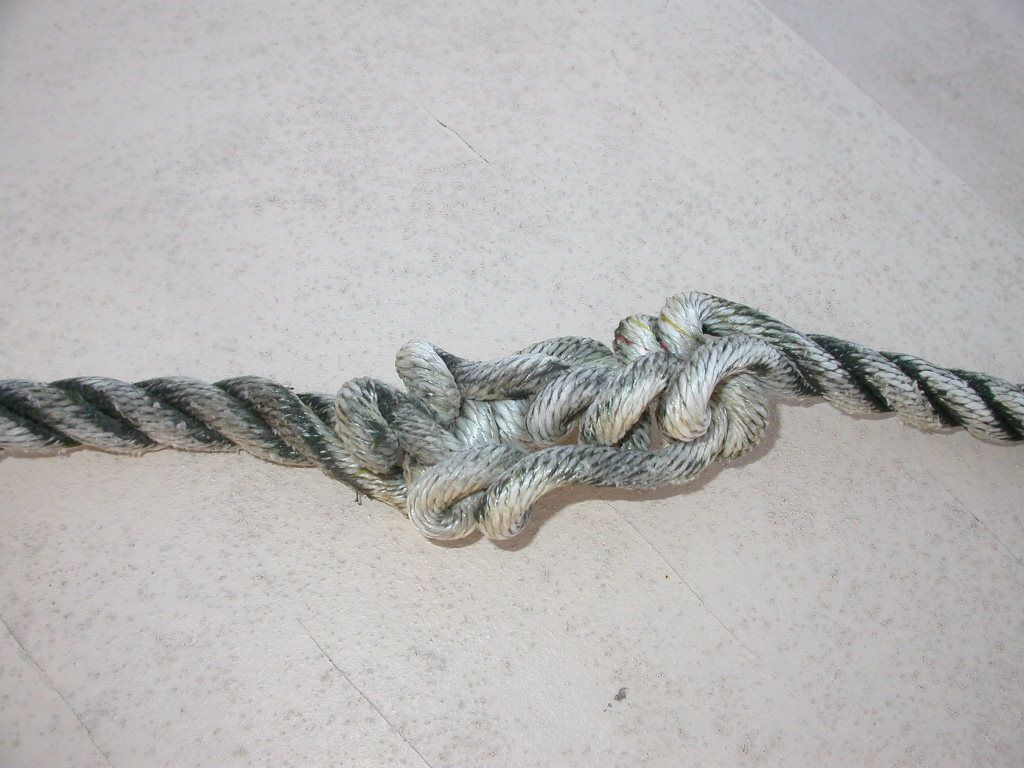 |
| The middle of one of my mooring pennants |
Anyway, the pennant clearly needed to be replaced.
At the same time, I was surprised to see that both lines were slightly chafed in an unexpected spot. I'd spliced a galvanized thimble into both lines, on the ends shackled to the mooring ball. Both lines were slightly chafed in this spot -- in the eye-splice around the thimble. Nothing dramatic, but I decided to add a bit of protection in this vulnerable spot, as I built my new pennant lines.
For parceling, I cut some 1" strips of canvas. Not for the first time, I wished I had some of that Pine Tar that Kirby sells. I'm going to buy some, ASAP. But I didn't have any, so proceeded without.
 |
| cutting 1" strips of canvas |
I tightly wrapped the strips around the line, using some tape to temporarily hold things in place.
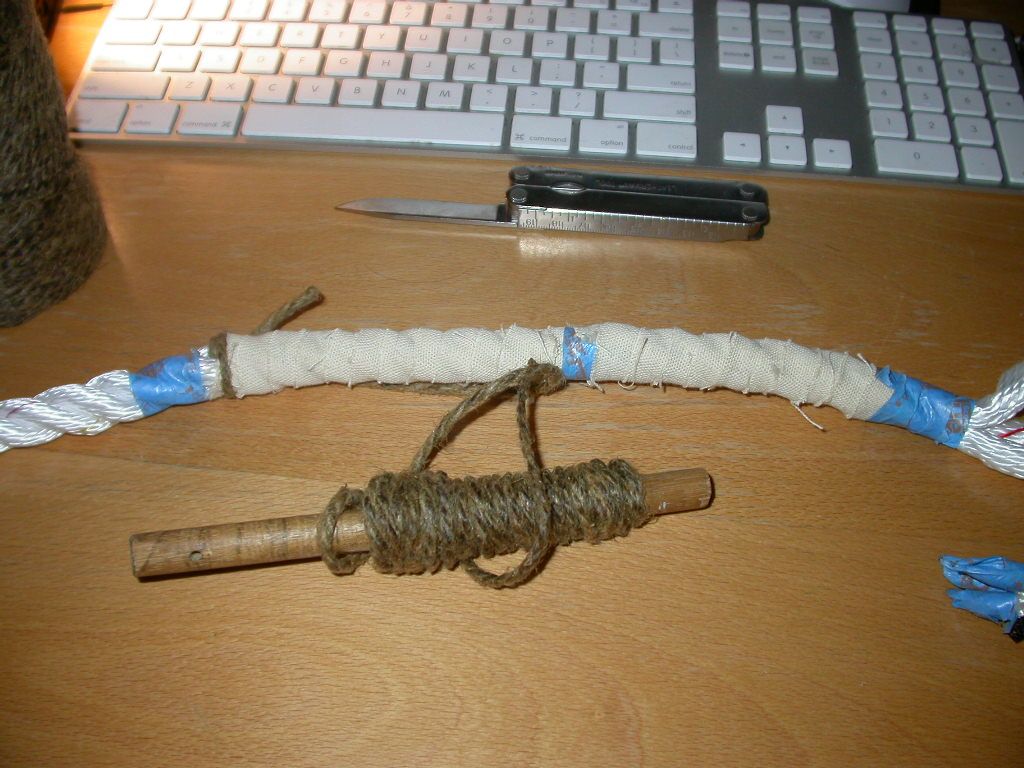 |
| 'parcelling' |
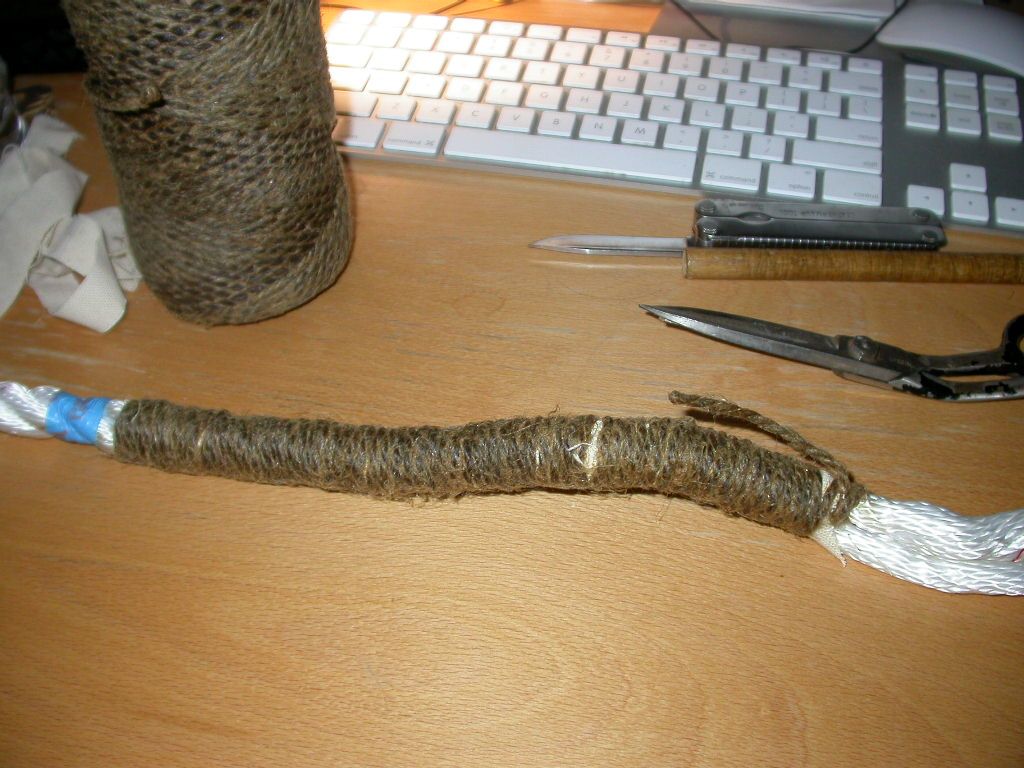 |
| 'service' |
Then it was a simple matter to splice the line around the thimble. After I get the first set of tucks in, I like to insert the thimble, so the splice can be tightened around it.
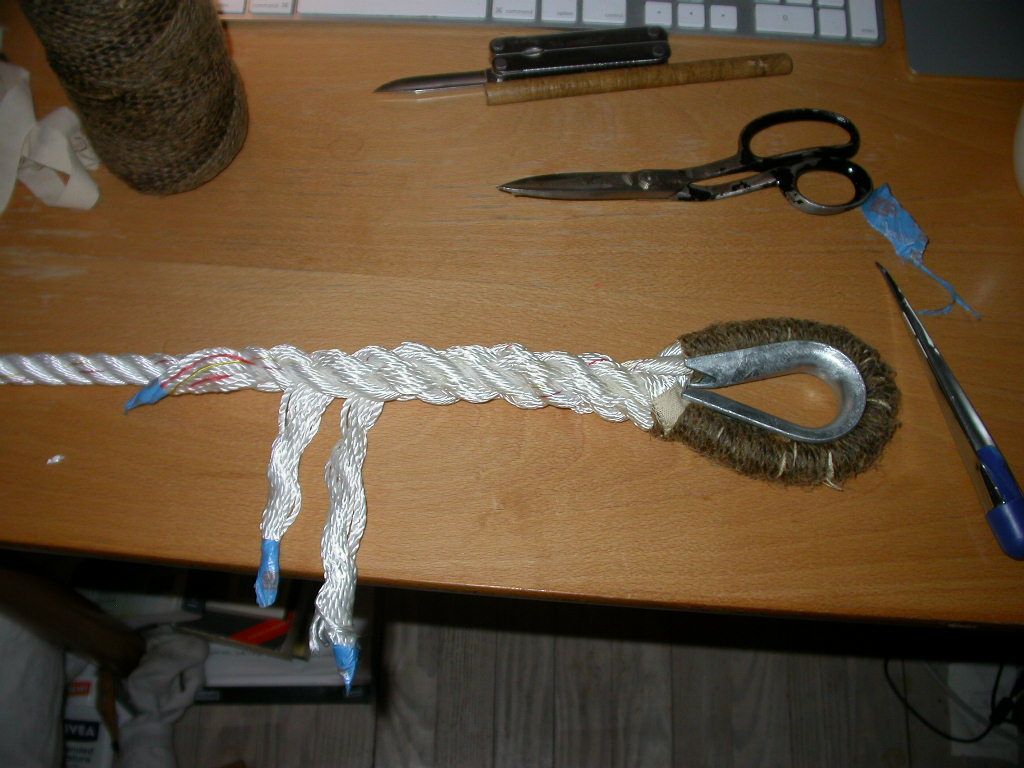 |
| with thimble spliced in |
Honestly, I don't think seizing is required, but I usually put some on anyway. It's the belts and braces approach to paranoia.
So, here it is all ready to go, with another eye spliced into the boat-end. I just slip this eye over the Samson post, when mooring.
Note that I slipped the piece of plastic hose over the line before splicing. I do not deal with split hoses. Whole hoses are the best chafe protection.
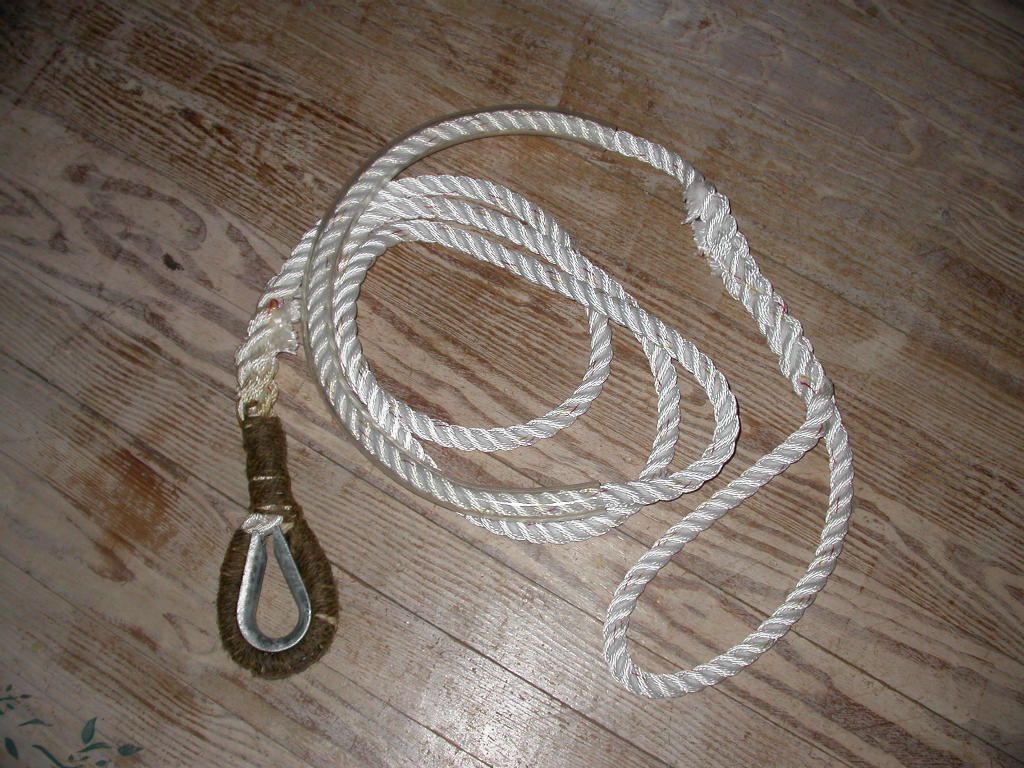 |
| New 5/8" pennant line with chafe protection at both ends |
And here it is installed on the mooring.
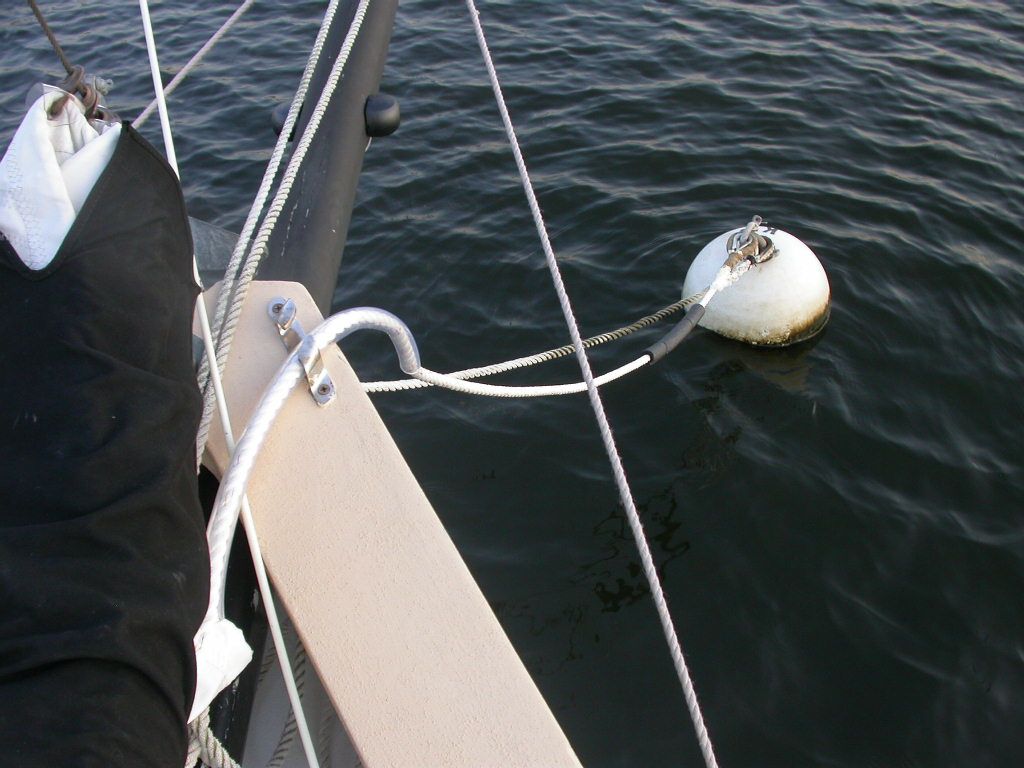 |
| New mooring pennant |
Finally, note the 2' of foam insulation wire-tied around the line near the mooring ball. This insulation floats and keeps the line from sinking at slack tide, and wrapping around the bottom of the mooring ball. This only happened once all summer, but the foam should prevent it from happening again.
So there you have it. I'll replace the undamaged pennant later this week, assuming some hidden weakness caused the snaggle in the other. (If you know the real name for a snaggle, please post it in the comments section, below.)
Anyone notice my new LED running lights installed on the bowsprit? Wow! About 100 times brighter than the old kerosene running lights. You know what they say: the smaller the boat, the brighter the lights should be.
I'm pretty much obsessed with finishing my book, so don't know how much time I'll have to blog, but winter is coming soon, so I'll have more time for projects and blogging, then. I have a new plan to finish my journey up the east coast next summer. I'm thinking of calling it "Maine or bust!"
But there's a whole lot of work to be done on the Blue Moon and Cabin Boy before then.
>>> Next Episode: Blue Moon Pics
I think the term might be "hockle".
ReplyDeleteI just googled this and think you might just have it.
DeleteNothing wrong with snaggle as the word to describe this, that I can see. I'm pretty sure that it was not caused just by the line being stretched, but much more likely by a twist in the line. If the line is twisted up _then_ stretched it will cause this unlaying effect. Perhaps you need a swivel in the pennant, although I've never seen one used.
ReplyDeleteThere are two swivels in the chain between the anchor and ball. I haven't seen any evidence of excessive twist (like the two mooring lines tightly twisted around each other), but who knows what happened during the storm. Something unusual, I guess.
DeleteI would also vote for "hockle." On the hose: I wonder if that might cause the line to heat up inside it? Seems like heat is being pointed to as a cause of line failure in stress situations.
ReplyDeleteI've heard this idea of rope melting inside a hose, but wonder if it's one of those urban legends. I've never seen any damage caused by the hose, and can't really understand the physics behind the melting idea. One thing I know: there's no better chafe protection.
DeleteThe clear hose lets you keep an eye on the line, but from 2 years of using it, the line under the hose is in better condition than the rest of it.
Great post. Learned a lot!
ReplyDelete